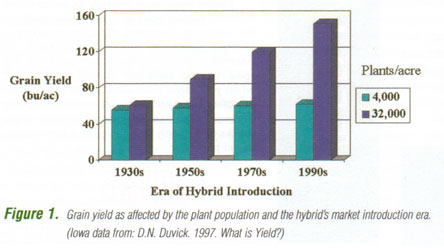
2001 Corn Planting Considerations
Plant Populations:
Have We Broken the 30,000 Ceiling?
Corn plant population has been an intensely studied aspect of corn production. The seed buyer has always been interested
in maximizing yields while spending the least amount possible on seed. However, over the years the trend has been
that higher yields, with modern hybrids, were generally produced with higher populations. In fact, the most significant
change in modern hybrids has been their ability to cope with the stress of increased density.
Figure 1 outlines research done where hybrids from various decades were all grown
to compare their yields under two extreme populations (4,000 and 32,000 plants
per acre). Note how old and new hybrids yield almost identically when grown under
low-density situations. You may question  whether plant breeding has made
any progress at all. But look at the massive yield response for the newer hybrids
when they are grown at the high density. The trend is very clear. Breeding programs
within seed companies realize that much of the potential yield gain has come and
will yet come from developing hybrids that excel under higher densities. So while
over the past decade we may have set 28-30,000 plants per acre as all you would
ever need to maximize corn yield, it wonít be true in the future. In fact, some
hybrids now on the market need over 30,000 plants per acre to maximize returns
to the grower. Work with your seed representative to fine-tune hybrid management
and planting density.
whether plant breeding has made
any progress at all. But look at the massive yield response for the newer hybrids
when they are grown at the high density. The trend is very clear. Breeding programs
within seed companies realize that much of the potential yield gain has come and
will yet come from developing hybrids that excel under higher densities. So while
over the past decade we may have set 28-30,000 plants per acre as all you would
ever need to maximize corn yield, it wonít be true in the future. In fact, some
hybrids now on the market need over 30,000 plants per acre to maximize returns
to the grower. Work with your seed representative to fine-tune hybrid management
and planting density.
Varying Population with Yield Potential
When considering optimum plant densities, many growers get concerned that they donít have the yield potential to
warrant bumping up seeding rates. This is a valid concern, particularly on drought-susceptible fields where water
availability, not light interception, is almost always the yield-limiting factor. Some savings can be realized
by adjusting populations downward in these types of situations. A recent research report published in the Agronomy
Journal (D. Bullock et. al., 1998) indicated that the optimum final plant population in the Midwest Corn Belt on
average is 27,160 plants per acre. These researchers also predicted, based on their work, that for every 15 bu/acre
increase in a fieldís yield potential (or parts of fields), economically optimal populations increased by 450 plants
per acre. So in Ontario, while we may generally shoot for higher average final stands than in the Midwest, you
will also want to ensure that your productive fields are near the upper end of the plant population range for the
hybrids you are planting.
Also note that in the shorter season areas of the province, where smaller stature hybrids are naturally grown,
populations may be under even more pressure to remain high to maximize light interception and optimize yields.
Donít let the fact that your yield goal is 105 bu/acre sway you into thinking that 24,000 plants per acre will
do the job.
| Table 1 Number of bushels per acre required to pay for a 4,000-seed/acre increase in planting rate for seed corn of various prices | ||
|
Cost per bag of seed |
Cost per 4000 seeds |
Additional bushels per acre require to break even. (Assume $ 3.00/ bu) |
|
$ 120 |
$ 6.00 |
2 |
|
$ 140 |
$ 7.00 |
2.3 |
|
$ 160 |
$ 8.00 |
2.7 |
|
$ 180 |
$ 9.00 |
3.0 |